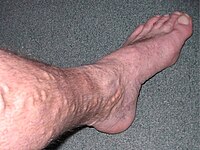
Photo from wikipedia
Abstract This article outlines the current best practice in the management of varicose veins. “Varicose veins” traditionally means bulging veins, usually seen on the legs, when standing. It is now… Click to show full abstract
Abstract This article outlines the current best practice in the management of varicose veins. “Varicose veins” traditionally means bulging veins, usually seen on the legs, when standing. It is now a general term used to describe these bulging veins, and also underlying incompetent veins that reflux and cause the surface varicose veins. Importantly, “varicose veins” is often used for superficial venous reflux even in the absence of visible bulging veins. These can be simply called “hidden varicose veins”. Varicose veins usually deteriorate, progressing to discomfort, swollen ankles, skin damage, leg ulcers, superficial venous thrombosis and venous bleeds. Patients with varicose veins and symptoms or signs have a significant advantage in having treatment over conservative treatment with compression stockings or venotropic drugs. Small varicose veins or telangiectasia without symptoms or signs can be treated for cosmetic reasons. However, most have underlying venous reflux from saphenous, perforator or local “feeding veins” and so investigation with venous duplex should be mandatory before treatment. Best practice for investigating leg varicose veins is venous duplex ultrasound in the erect position, performed by a specialist trained in ultrasonography optimally not the doctor who performs the treatment. Pelvic vein reflux is best investigated with transvaginal duplex ultrasound (TVS), performed using the Holdstock-Harrison protocol. In men or women unable to have TVS, venography or cross-sectional imaging is needed. Best practice for treating truncal vein incompetence is endovenous thermal ablation. Increasing evidence suggests that significant incompetent perforating veins should be found and treated by thermal ablation using the transluminal occlusion of perforator (TRLOP) approach, and that incompetent pelvic veins refluxing into symptomatic varicose veins in the genital region or leg should be treated by coil embolisation. Bulging varicosities should be treated by phlebectomy at the time of truncal vein ablation. Monitoring and reporting outcomes is essential for doctors and patients; hence, participation in a venous registry should probably be mandatory.
Journal Title: Clinical, Cosmetic and Investigational Dermatology
Year Published: 2022
Link to full text (if available)
Share on Social Media: Sign Up to like & get
recommendations!